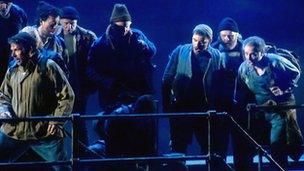The Flying Dutchman: A Wagnerian chorus in Peterhead
- Published

The Flying Dutchman has been set in Peterhead by Scottish Opera
A ship pulls into a grey dock.
The men, weighed down by their oilskin jackets, clamber down ladders and file slowly into the steamed up chip shop in the harbour.
All the time, singing a Wagnerian chorus.
So begins The Flying Dutchman. Only this Scottish Opera version sets the story on the north east coast of Scotland. Peterhead in the 1970s to be precise.
"I suppose the designer and I were keen to capture that image," says director Harry Fehr. "The grey, the steel, the oilskins, the darkness of it all.
"It's not a beautiful, romantic production. It's much darker, blunter."
Richard Wagner's tale of a mysterious ghost ship was originally set in Scotland.
Fehr tracked down the original score in the British library where the character of Daland is Donald, and there's a ceilidh for the sailors, not to mention other Scottish elements.
'Very fashionable'
So why did Wagner abandon his plans just a month before the premiere in Dresden in 1843 and reset it on the coast of Norway?

Director Harry Fehr said Scotland featured in books and music at the time
"No one really knows but I think there were a couple of reasons," says the director.
"Scotland was very fashionable at the time in books and music. Wagner would have read Sir Walter Scott.
"But he was also aware that other composers were using Scotland and he may have wanted to stay ahead of fashion.
"As well as that, Wagner liked to include an autobiographical strand to his work and he had been caught in a storm on a ship on the way to London a few years before.
"They'd taken shelter in a Norwegian fjord and that may have influenced his decision to set the opera in Norway."
This is the 200th anniversary of Wagner's birth and a number of productions are planned, including several of The Flying Dutchman.
Opera Northern Ireland recently staged a version set in the 1970s but this is thought to be the first version of the original opera, on UK soil.
Complete with oilskins, grey granite and fish and chips.
The Flying Dutchman opens in Glasgow's Theatre Royal on Thursday.